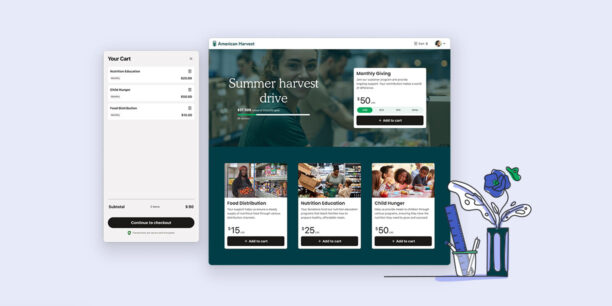Data Privacy and Security Changes: The Implications of iOS 14.5 and iOS 15 for Nonprofits

Request a Demo
Learn how top nonprofits use Classy to power their fundraising.
This post is written by Nick Ilev of Proper Expression. Nick has more than 10 years of digital marketing experience devising and executing innovative web strategies for complex organizations.
Questions about data privacy and security continue to spring up in digital marketing discourse. This is for good reason. Customers deserve transparency and input in how (or if) their data is used.
Data privacy changes continue to evolve. Now, Apple is the latest player in the movement by introducing new iOS updates that come with advanced privacy technologies.
These updates are far from routine: iOS 14.5 and iOS 15 create a major, unprecedented paradigm shift in the world of digital advertising. The new data privacy and security features will have a large impact on individuals, advertisers, and nonprofit organizations alike.
Learn how to pivot your advertising and email marketing strategies in the face of these new updates to continue advancing your nonprofit mission.
Download the Nonprofit Digital Marketing Checklist
iOS 14.5 Overview: The Difference It Makes to Advertisers and Nonprofits
Apple released the iOS 14.5 update in spring 2021, which came with significant privacy changes. The biggest feature of note for marketers is called App Tracking Transparency (ATT).
What App Tracking Transparency Does
ATT requires apps to get a user’s permission to be tracked. Essentially, if someone is using an app on their Apple device, they must opt in to allow tracking of their web and app activity.
Access to the Identification for Advertisers (IDFA), a code that advertisers use to identify and retarget consumers, is now limited as a result.
Why the Change?
Simply put, Apple is making changes to protect its users’ privacy and keep them more informed. It’s an ethical move meant to enhance transparency into how advertisers use a consumer’s information.
How Apple’s Changes Impact Nonprofits
Like traditional advertisers who need to attract customers to fuel their business, nonprofits need to raise awareness and attract donors to support their causes through a strong revenue marketing strategy. One important way to accomplish these goals is through channels like Facebook and Instagram advertisements.
4 Types of Paid Advertising That Increase Donations
Social media is a critical medium for advertisers to drive conversions through organic presence and paid ads. In fact, 51 percent of campaign traffic on Classy came from social media in 2020.
With the iOS 14.5 privacy updates, the efficacy of tracking and conversion attribution in Facebook advertising becomes more difficult for Apple audiences.
Ad retargeting is no longer available for iOS users who opt-out of tracking, so Facebook’s tracking pixel effectiveness diminishes dramatically. Nonprofit advertisers will be shooting in the dark when it comes to marketing to iOS users.
Due to the lack of tracking capability and eroded data clarity, an entire segment of the ad audience will be hidden. This change will skew ad performance reporting and trigger a decline in ad personalization, making it more difficult for nonprofits to accurately target donors who use Apple devices. Poor targeting also means wasted ad spend.
Apple’s move generated responses from other leaders in tech as well, like Google. The company informed developers and advertisers of its own updated privacy measures and the impact of these advancements, emphasizing the importance of user privacy.
Meanwhile, Facebook brought up the negative impact for businesses that advertise on their platform, saying “As more people opt out of tracking on iOS 14 devices, ad personalization and performance reporting will be limited for both app and web conversion events.”
iOS 15 Overview: How Email Privacy Changes Further Alter the Marketing Landscape for Nonprofits
The new iOS 15 update rolled out in September 2021 and came with additional privacy features that impact email marketers.
What to Know About the iOS 15 Update
Two significant email privacy changes came with the iOS 15 rollout:
- Mail Privacy Protection: This update obscures a recipient’s action upon receiving an email, so the sender will be unable to tell if they opened it. Mail Privacy Protection also hides a user’s IP address so their location cannot be determined.
- Hide My Email: As part of the iCloud+ subscription, Hide My Email lets users share random email addresses that forward to their inbox to keep their personal information private.
How It Impacts Nonprofits
Nonprofit organizations rely heavily on email marketing to share updates with their community, raise awareness, and drive fundraising efforts. The iOS 15 update significantly changes the way email marketers operate, so nonprofits should educate themselves on the changes to stay ahead.
- Inflates Email Open Rates: Apple will load tracking pixels on behalf of their users, which means that it will appear to the sender as if the email has been opened, whether or not the user actually does it themselves. Because of this change, open rates will appear much higher than they really are, making it more difficult to know the true success of your email campaign.
- Skews A/B Testing: Since open rates will be less reliable, it will be tricky to get accurate A/B testing results. Marketers will have a more difficult time determining the most successful email strategy since the data lacks full clarity.
- Hinders Location-Based Email Targeting: Nonprofits will face a greater challenge when trying to personalize emails or connect with a segmented community due to hidden user locations.
The iOS 15 changes rolled out right before year-end, which is the time nonprofits are prepping for their busiest giving season.
Data from Classy’s State of Modern Philanthropy Report tells us that nearly one-third of all giving on the Classy giving platform takes place between Giving Tuesday and December 31. It’s a tight window to pivot strategy in response to the new privacy hurdles.
Learn How to Elevate Your Year-End Fundraising to Raise More
How Nonprofits Can Work Around the Changes
The best thing to do in light of these updates is to embrace and adapt to the shift. In all likelihood, privacy changes like this will continue, and it is the ethical position to support user privacy protection. There are a few things nonprofits can do now to adjust their strategy to reach and understand their audiences on a deeper level:
- Target Android Donors: Remember, Android users are free of new privacy updates, so you can still segment this demographic and achieve more accurate ad reporting.
- Invest in Organic Social Media and SEO: As privacy changes continue to evolve, attract donors with your messaging and brand personality. Prioritize organic content, particularly on social media. Optimize your website for search engine optimization (SEO) to improve your rank in search results, and attract more visitors without worrying about privacy restrictions.
- Ditch Open Rates and Look at Other Email Metrics: Since open rates are not as accurate as they were before, focus on other email metrics to understand your campaign success. You can examine unsubscribe rate, click-through rate, and unique clicks to get started.
- Create Quality Email Content: Reach donors with interesting, impactful content, starting with your subject lines. Because clicks are critical for your reporting, drive conversions with compelling donation buttons, engaging text, and user-friendly email design.
- Tap Into Paid Search Ads: There are still a few ads that remain unimpacted by the privacy changes. Continue to leverage these marketing opportunities to reach new donors through paid search and pay-per-click advertising.
The Future of Data Privacy and Security
Apple plans to adopt more data privacy features beyond just iOS 15. When the macOS 12 Monterey releases in late 2021, privacy protection will arrive for the macOS Mail app as well.
In addition, Google announced that it will be discontinuing the third-party cookie by late 2023, changing the way digital marketers collect data. To prepare, nonprofits should begin to shift their strategy to focus on first-party data rather than third-party data.
First-party data is the free information you collect from your audience or customers, including things like website activity, social media data, customer survey results, CRM data, and more. Third-party data is purchased from other companies and it can offer a wider perspective on your target market.
Stay Educated to Stay Ahead
Stay up-to-date on the evolving data privacy and security trends to ensure the future success of your nonprofit’s digital advertising and email marketing strategies.
Continue to create quality content, build genuine relationships with donors, and focus on spreading your message through organic avenues.
For more insight on how to navigate these evolving trends, explore this list of additional resources:
Posted in Fundraising Marketing Business & Tech

The Nonprofit Digital Marketing Checklist
Subscribe to the Classy Blog
Get the latest fundraising tips, trends, and ideas in your inbox.
Thank you for subscribing
You signed up for emails from Classy
Request a Demo
Learn how top nonprofits use Classy to power their fundraising.
 Explore Classy.org
Explore Classy.org 

